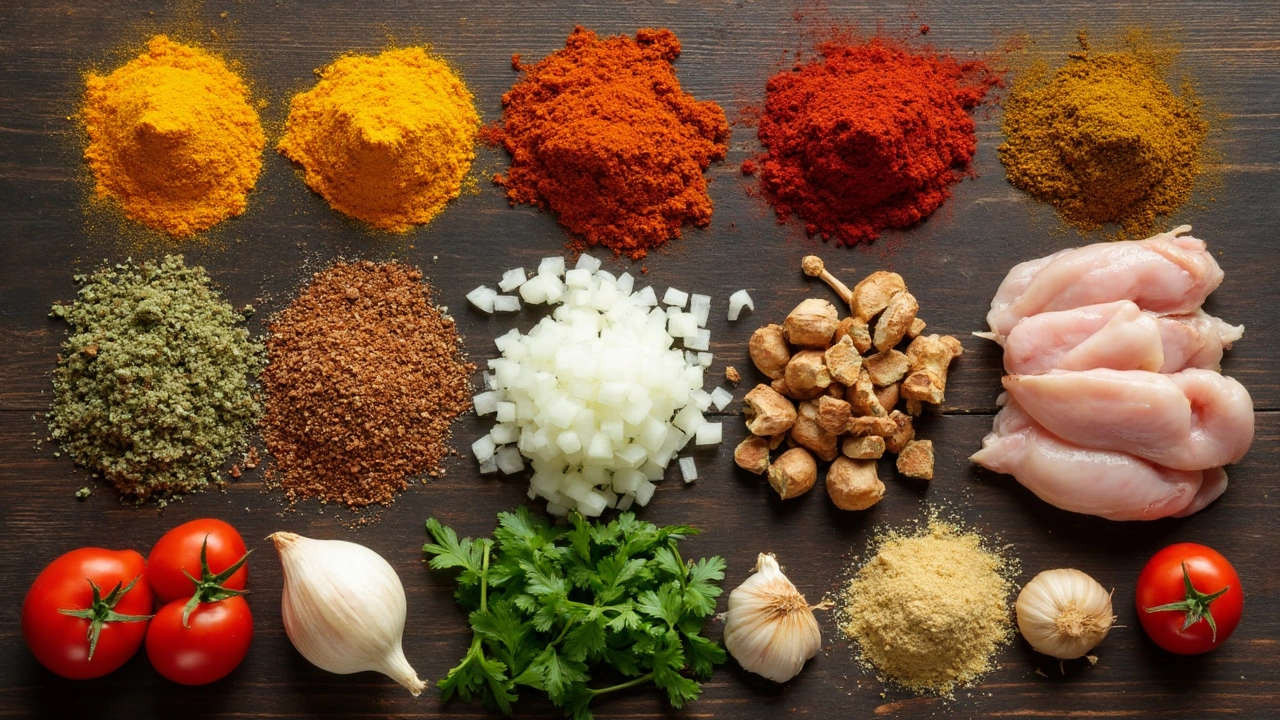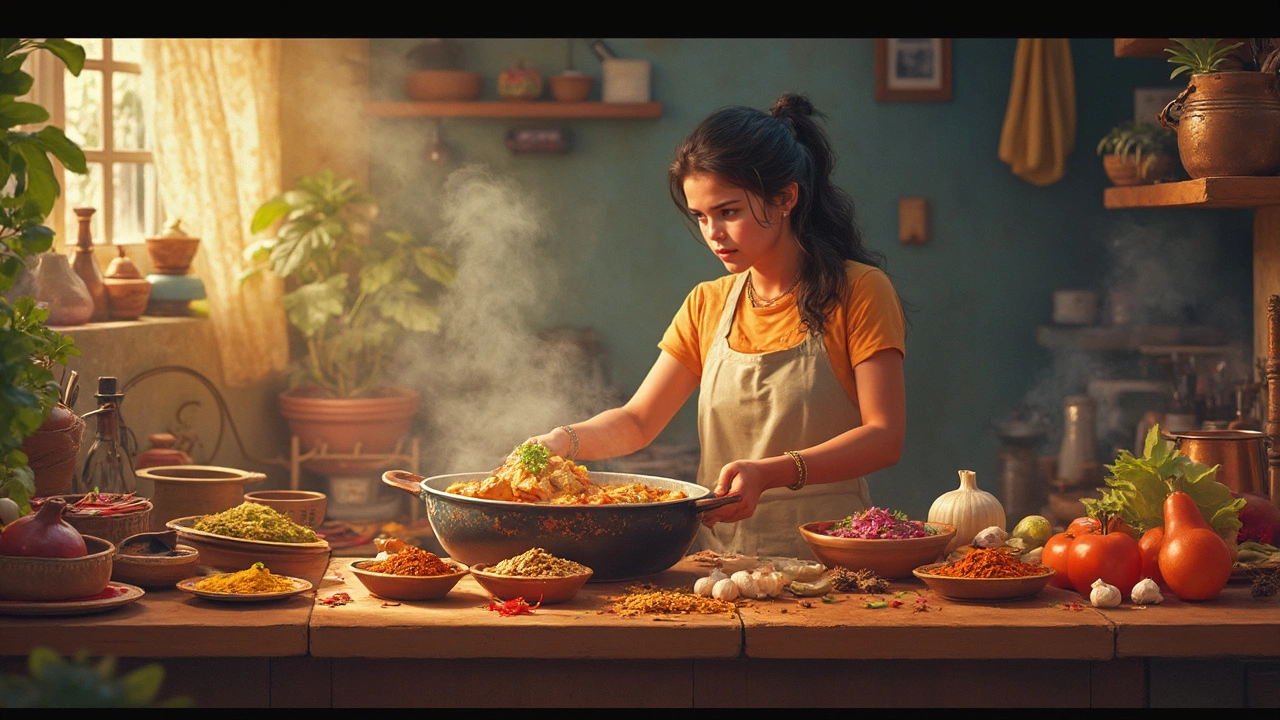If you’ve ever wondered what’s actually inside a real curry—especially chicken curry—you’re not alone. So many recipes throw around the word “curry” like it’s just another kind of stew, but there are certain things you’ll nearly always find in the real deal.
Let’s start with the basics: every traditional curry kicks off with a handful of usual suspects. Think onion, ginger, and garlic. These get chopped or smashed and sautéed to unlock flavor; skip them, and your curry just won’t taste ‘complete’.
Next, curry isn’t curry without a blend of spices. You can’t just toss in a generic “curry powder” and hope for the best. Real recipes call for things like cumin, coriander, turmeric, and often chili powder—each one adds its own punch. A neighbor of mine even sneaks in a pinch of garam masala at the end, and wow, it never fails.
- Foundations of a Classic Curry
- Spices That Really Matter
- Vegetables and Aromatics
- Meat and Protein Choices
- Tips for Authentic Flavor
Foundations of a Classic Curry
If you break down any solid chicken curry recipe, you’ll always bump into a few basics that show up every single time. Forget the idea that curry is anything you toss in a pot. There’s a method behind those layers of flavor that make you want to mop up every drop with naan.
First things first, the "holy trinity" for almost all Indian curries is onion, ginger, and garlic. These aren’t just tossed in for decoration—they seal in flavor and set the ground rules for what comes next. You usually want roughly equal amounts of onion, and much less ginger and garlic, but together they create the backbone of nearly any traditional curry.
The base is usually built like this:
- Onions: Sautéed until they’re golden brown. This is where patience pays off—rush it, and you miss the sweetness that gives curry depth.
- Ginger and Garlic: Added after the onions, and cooked until the raw smell disappears. Some cooks use a paste for this part, making sure it’s smooth without chunks.
- Tomatoes: These go in once the onion-ginger-garlic mix comes together. Tomatoes add acidity and body, plus help the spices grab onto something.
You can see it in kitchens all across India (or in my own kitchen, especially on weekends): this combo gets the ball rolling. Missing even one of these can cost the curry big time in the flavor department.
| Ingredient | Amount |
|---|---|
| Onion (chopped) | 2 medium |
| Ginger (grated) | 1 tablespoon |
| Garlic (minced) | 1 tablespoon |
| Tomatoes (chopped or pureed) | 2 medium |
This trio builds the canvas for stronger flavors, especially for the curry ingredients that come next. If you get the base right, you’re halfway to nailing the taste you’ve had at good Indian restaurants—even if you’re just cooking in a basic kitchen.
Spices That Really Matter
Without the right spices, curry just ends up bland and boring. There are a few spices you’ll find in nearly every chicken curry recipe from India or South Asia, and for good reason—they bring all the classic flavor and warmth.
First up is turmeric. This is what gives curry its bright yellow color and a little earthy, peppery kick. You don’t need a ton—just half a teaspoon can transform a whole pot. Next, there’s cumin, usually in the form of ground powder, but whole cumin seeds work too. Cumin adds that toasty, nutty flavor in the background.
Coriander is another must. Ground coriander seeds mellow out the heat and add a lemony hint you might not expect. Then you’ve got chili powder, which decides how hot things get. If you’re not a fan of major heat, go easy on it—kids like Neerav definitely appreciate a milder kick. On the other hand, more adventurous folks in my family beg for the spicy version!
Last but definitely not least is garam masala. This is a spice mix rather than a single ingredient, and it almost always goes in at the end for a blast of fragrance. Garam masala can contain cinnamon, cloves, cardamom, and a bunch of other warming spices all ground together.
- Tip: Freshly ground spices are way more flavorful than the stuff that’s been sitting in your cupboard for years. If you have a coffee grinder or mortar and pestle, try grinding whole cumin or coriander seeds yourself. The flavor is seriously next level.
- Don’t stress about getting every spice perfect. Start with turmeric, cumin, and coriander, then add chili and garam masala. Adjust to your taste (and your family’s heat tolerance).
- If you ever run out of one spice, you can still make a yummy curry—just double up on something else and see how you like the change.
Using the right mix—not too complicated, but not too plain—makes a curry stand out. Try playing around with the amounts, and soon you’ll find your sweet spot.

Vegetables and Aromatics
When it comes to what’s traditionally in curry, vegetables and aromatics play a huge role in both flavor and texture. If you peek into any classic chicken curry recipe, you’ll spot onions right at the start. Chopped onions don’t just add taste—they also help build that thick, rich base sauce that hugs every piece of chicken.
Garlic and ginger come next, and honestly, skipping them is a bad idea. Some people use a paste made from equal parts fresh ginger and garlic; it’s quick, and the flavor difference is obvious. These two aren’t just there for a kick—ginger tones down the chicken’s flavor, and garlic adds depth.
As for actual veggies, tomatoes are one that shows up everywhere. Toss in chopped fresh tomatoes or a couple of spoonfuls of tomato puree. Tomatoes break down, add a bit of tartness, and help turn onion-ginger-garlic into a real curry sauce.
If you’re aiming for a proper curry ingredients list, green chilies are another classic, especially in Indian-style curries. They bring heat, but you can totally remove the seeds if you want less spice (my son Neerav can’t handle the very spicy stuff, so I get it). For extra flavor, you can try tossing in curry leaves if you find them. They aren’t a must, but honestly, they can make you feel like you’ve stumbled into someone’s South Indian family kitchen.
- Onion is non-negotiable—it’s in nearly every traditional recipe.
- Fresh ginger and garlic, either chopped or as a paste, really boost flavor.
- Tomatoes help with body and slight tanginess.
- Green chilies add real kick—easy to adjust based on your crowd.
- Optional: curry leaves or even a dash of fresh cilantro at the end if you want to impress.
Keep these basics on hand, and you’ll be set for almost any chicken curry recipe you want to try.
Meat and Protein Choices
Walk into any kitchen where chicken curry bubbles on the stove, and you’ll notice there’s almost always a type of meat or protein that acts as the star. For traditional Indian curry, chicken takes the top spot. Why chicken? It’s tender, easy to get, cooks fast, and the pieces soak up spices like nothing else. You’ll usually see chicken thighs or drumsticks—these parts have a bit more fat and flavor, so the result is juicier than using dry chicken breasts.
But here’s the thing: Indian home cooks don’t just stick to chicken. Lamb, goat, and even fish pop up in regional recipes. Vegetarians swap in paneer (that’s Indian cottage cheese) or chickpeas if they want the same rich taste, minus the meat. But when you see "chicken curry" on a menu—whether it’s in Delhi, London, or New York—it’s probably using bone-in chicken for deeper flavor. Boneless is fine, especially if you want quick weeknight cooking, but cooks say the sauce just turns richer and thicker when bones are involved.
Not every curry uses meat. Lentils, eggs, and even tofu have their place. But tradition leans hard toward animal protein or paneer in classic, homestyle curries.
Here’s a quick comparison of protein choices found in curries around the world:
| Protein | Region | Notes |
|---|---|---|
| Chicken | India, UK, Southeast Asia | Most common for home cooking |
| Lamb/Goat | North India | Often for special occasions |
| Fish | Bengal, South India | Popular in coastal areas |
| Paneer | India | Vegetarian favorite |
| Chickpeas | India, Middle East | Main in vegetarian curries |
If you ever get stuck or feel nervous about experimenting, remember this: the base flavors from the onion, ginger, and garlic will work with almost any protein you pick. But for a tried-and-true chicken curry, bone-in cuts are the go-to for the deepest flavor and juiciest texture.

Tips for Authentic Flavor
Getting the flavor right in a homemade curry isn’t just about tossing in spices and hoping for the best. Small details have a huge impact on that restaurant-style taste. So, if you really want your curry ingredients to shine, don’t skip these tips.
The first trick? Toast those whole spices. If you’re using things like cumin seeds, mustard seeds, or cardamom pods, let them sizzle in hot oil for a minute before any onions hit the pan. This wakes up those flavors, and you’ll smell the difference immediately. My son Neerav always runs to the kitchen when he catches that toasty aroma—it’s the real start of curry magic.
Next, cook your onions a bit longer than you think you should. Most chicken curry recipes get their color and depth from deeply browned onions. On medium heat, this usually takes about 10-12 minutes, and it’s worth every second. If you rush this part, you’ll end up with a watery, bland sauce.
Want a thick, clingy curry? Blend your cooked onions, tomatoes, and aromatics into a paste, then simmer everything with the meat. This trick gives you that smooth restaurant gravy without using cream. In fact, check out this rough breakdown of what most home cooks add for body in North Indian chicken curry:
| Thickener | Percentage of Home Recipes (India) |
|---|---|
| Blended Onion-Tomato | 70% |
| Yogurt/Curd | 18% |
| Cream or Coconut Milk | 10% |
| Cashew Paste | 2% |
Don’t forget the finishing touch—add a sprinkle of garam masala, chopped cilantro, or a squeeze of lemon just before serving. These extras make your curry pop and help cut through rich flavors. My go-to move is a squeeze of lemon and a spoonful of fresh coriander, right at the end.
- Toast spices in hot oil to boost aroma.
- Brown onions slowly for extra flavor.
- Blend sauce base for a silky texture.
- Add finishing toppings for freshness.
Stick to these details, and you’re already ahead of the average chicken curry game—no mystery takeout required.
